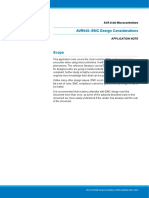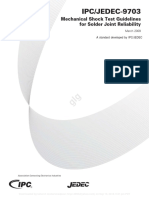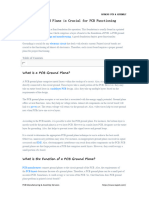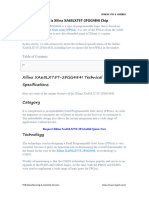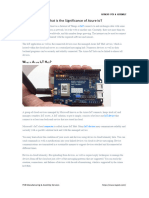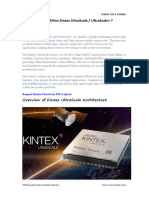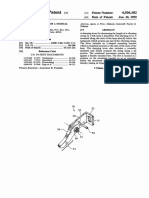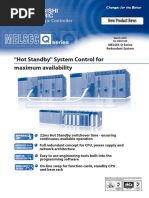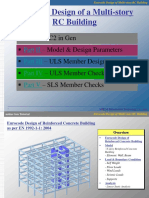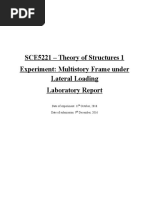What Is Prepreg in PCBs
What Is Prepreg in PCBs
Uploaded by
jackCopyright:
Available Formats
What Is Prepreg in PCBs
What Is Prepreg in PCBs
Uploaded by
jackOriginal Description:
Original Title
Copyright
Available Formats
Share this document
Did you find this document useful?
Is this content inappropriate?
Copyright:
Available Formats
What Is Prepreg in PCBs
What Is Prepreg in PCBs
Uploaded by
jackCopyright:
Available Formats
RAYMING PCB & ASSEMBLY
What is Prepreg in PCBs?
Introduction
Prepreg, also referred to as pre-impregnated composite fibers, is a key
material used in the manufacture of multilayer printed circuit boards
(PCBs). It is a fibrous reinforcement that has been pre-impregnated with a
resin system prior to laminating PCB layers together.
Prepregs provide electrical isolation between the conductive copper layers
in a PCB while also offering mechanical stability. They impart crucial
properties like dimensional stability, bond strength, heat resistance and
dielectric performance. Selecting the right prepreg material is critical for
the reliability of multilayer PCBs used in electronics.
This article provides an overview of PCB prepregs covering their
composition, properties, types, role in the PCB fabrication process and
methods for quality control testing.
Composition of PCB Prepregs
Prepregs used for PCB fabrication are generally composed of:
Fiberglass fabric reinforcement
Epoxy or other polymer resin systems
Filler particles like silica
PCB Manufacturing & Assembly Services https://www.raypcb.com/
RAYMING PCB & ASSEMBLY
Catalysts and accelerators
Flame retardants
Fiberglass Fabric
The fiberglass fabric provides mechanical strength and dimensional
stability. Some types used are:
108, 211 fiberglass with 5-15 μm diameter fibers
Woven fabric with different weave styles
Non-woven random fiber mats
Resin System
The resin coats and bonds together the fibers. Different resin types used
are:
Epoxy – Most common for FR-4 grade prepregs
Polyimide – For high temperature PCBs
BT (Bismaleimide Triazine) – Low moisture absorption
Cyanate ester – High frequency, low loss PCBs
Fillers
Fillers like fused silica reduce the coefficient of thermal expansion (CTE) of
the composite to match copper. They also control flow, adhesion, thermal
conductivity and cost.
PCB Manufacturing & Assembly Services https://www.raypcb.com/
RAYMING PCB & ASSEMBLY
Other Components
Small amounts of curing agents, accelerators, flame retardants and other
additives tailor the prepreg properties.
Request PCB Manufacturing & Assembly Quote Now
Properties of PCB Prepregs
Prepreg 1080
Desirable properties in prepregs for quality PCBs:
Dielectric Constant – Stable dielectric constant and low dissipation factor
for high frequency performance. Values of 3.5-5 typical for glass
fabric-epoxy prepregs.
Dimensional Stability – Low Z-axis shrinkage and expansion under
temperature cycling to avoid via failures. Typical X-Y shrinkage < 0.5%.
Bond Strength – Strong adhesion to copper foils and between prepreg
layers with good resistance to delamination. Bond strength > 2.5 N/mm.
PCB Manufacturing & Assembly Services https://www.raypcb.com/
RAYMING PCB & ASSEMBLY
Decomposition Temperature – High Td above 300°C indicates stable
thermal performance and prevents charring issues.
Moisture Absorption – Low affinity for moisture prevents electrical leakage
and reliability issues due to vapor pressures. <0.5% uptake standard.
Flow and Filler – Adequate resin flow to fill irregularities but not excessive
to avoid shorts between conductors. Filler loading around 15-40%.
Flame Retardancy – High degree of flame resistance with resistance to
ignition, burning and smoke generation. UL 94 V-0 rated material.
Types of PCB Prepregs
Many varieties of prepregs cater to different PCB performance
requirements:
Type Key Characteristics
FR-4 Epoxy Most widely used. Good processability. Low cost. Temperature rating 130°C (Tg 135-155°C)
High Tg Epoxy Tg > 170°C for higher heat resistance. Ex: BT epoxy, Allied Signal Arlon 85N
PPO (Polyphenylene oxide) Low loss and stable Dk for RF/microwave. Improved Z-axis CTE. Ex: Rogers TMM 10i
Cyanate Ester Lowest loss, tightly controlled Dk for high freq. Ex: Taconic TacPreg CE
PTFE Composite Extremely low Dk ~2.2. Low loss. Ex: Rogers RO3003
Polyimide Very high Tg >240°C, low Z-axis expansion. Ex: DuPont Kapton VN, Hitachi PI-2525
Non-woven Aramid High bond strength. Low CTE for large boards. Ex: Isola Preperm P92
The choice depends on thermal, electrical and high frequency
requirements.
Role of Prepreg in PCB Fabrication
PCB Manufacturing & Assembly Services https://www.raypcb.com/
RAYMING PCB & ASSEMBLY
Prepreg performs several crucial functions in the PCB fabrication process:
1. Bonding Layers
Prepreg is used to bond the inner copper layers into a multilayer board
through lamination under heat and pressure.
2. Electrical Isolation
It provides electrical isolation between two conductive copper sheets or
internal planes while still allowing conduction through drilled holes.
3. Inner Layer Core
Prepreg-copper sheets also serve as the starting cores during the layup of
multilayer PCBs.
4. Serving Solder Mask
PCB Manufacturing & Assembly Services https://www.raypcb.com/
RAYMING PCB & ASSEMBLY
Special prepreg with photo-sensitive resin can act as the solder mask layer
on outer surfaces.
5. Imparting Rigidity
The composite material lends mechanical strength and rigidity to the PCB
structure.
6. Controlling Z-axis CTE
Low expansion prepregs control growth along thickness to avoid reliability
issues.
7. Providing Heat Resistance
High Tg prepregs allow PCB operation at elevated temperatures.
8. Establishing Dielectric Constant
The resin-fiber matrix governs the dielectric constant of the insulating PCB
layers.
PCB Prepreg Handling Considerations
To maintain quality, prepregs require careful handling:
Prepregs are supplied sealed in polythene bags to prevent moisture
absorption. Unused prepreg should be resealed immediately.
PCB Manufacturing & Assembly Services https://www.raypcb.com/
RAYMING PCB & ASSEMBLY
Storage temperature should be 18-25°C. Freezing conditions can
ruin the material while excessive heat can cause partial curing.
Shelf life is typically 1 year at 23°C. Prepregs should be used on a
FIFO basis before expiry.
Allow refrigerated prepreg to reach room temperature before
opening to prevent moisture condensation.
Avoid excessive exposure to UV light which can initiate
polymerization. Use under yellow light.
Use clean lint-free gloves when handling to avoid contamination of
the tacky surfaces.
Proper prepreg handling as per manufacturer guidelines ensures
consistent performance.
PCB Prepreg Testing
Some key tests carried out on prepreg materials for quality control are:
PCB Manufacturing & Assembly Services https://www.raypcb.com/
RAYMING PCB & ASSEMBLY
Resin Flow Testing
Resin viscosity measured at standard temperature and pressure
Tested after partial curing for specified duration
Ensure adequate but controlled flow during lamination
Gel Time Test
Monitoring resin polymerization at set temperature
Inflection point taken as gel time
Checks adequate processing window before curing
Differential Scanning Calorimetry
Monitors heat flow versus temperature to detect transitions
Gives resin glass transition temperature, cure peaks
Indicates degree of curing with heat ramps
Dielectric Constant
Measured over frequency range like 10 MHz – 10 GHz
Indicates electrical insulation capability
Stable value desired through frequency spectrum
Flammability Testing
UL 94 vertical burning test rating for flammability
PCB Manufacturing & Assembly Services https://www.raypcb.com/
RAYMING PCB & ASSEMBLY
High priority for safety critical PCB applications
Prepreg received from supplier is also tested before PCB usage.
Conclusion
Prepreg forms the fundamental dielectric building block of multilayer
PCBs that electrically isolates the conductive layers while also imparting
mechanical strength. The composition of the resin, fabric reinforcement
and fillers that make up prepreg governs the thermal, electrical and
reliability performance of the PCB. With the diversity of prepreg types
available, PCB manufacturers can select the optimal material suited for
their performance requirements and process compatibility. Strict handling
and quality control measures for prepreg also minimize variability and
ensure consistent results during PCB fabrication. As PCBs become thinner
and operate at higher frequencies and temperatures, engineering the
prepreg materials is critical for enabling their miniaturization and
reliability.
Frequently Asked Questions
Q1. How does prepreg material selection influence the fabrication process of
multilayer PCBs?
Some ways prepreg properties affect multilayer PCB fabrication are:
PCB Manufacturing & Assembly Services https://www.raypcb.com/
RAYMING PCB & ASSEMBLY
Flow viscosity during lamination cycle time and temperature
Tg impacts the curing required and potential rework
Low thermal expansion suits large area boards
High filler suits complex topographies
Adhesion levels affect press parameters
Moisture sensitivity influences handling
Dielectric properties affect impedance control
Q2. What are some troubleshooting tips for issues with PCB prepreg?
Troubleshooting tips for prepreg related PCB issues:
Delamination or blistering – Poor adhesion, high moisture
absorption
Cracking or crazing – Excessive resin flow, filler settlement
Poor dimensional stability – High Z-axis CTE material
Wicking or shorts – Insufficient resin viscosity
High dielectric constant – Incompatible resin system
Poor heat resistance – Low Tg material used
So proper prepreg selection, handling and process controls are vital.
Difference between PCB Core and Prepreg Materials
PCB Manufacturing & Assembly Services https://www.raypcb.com/
RAYMING PCB & ASSEMBLY
Prepreg Core is the isolating material of the PCB, often referred to as
before laminating. Manufacturers mostly use Prepreg as a binding
substance. Not just that, experts also employ it as a multifunctional PCB
inner conduction material. Thus, once the user laminates the Prepreg &
extrudes the half-healed epoxy, it solidifies and runs and binds the
multilayer panels together to create a dependable insulator.
When the distinction between both Core and Prepreg is evident, what
specific property should you use? When plate, etching, and drying, how do
crucial electrical characteristics change? As more manufacturers are aware
of the work at GHz frequency range, these principles are vital to size traces
of these materials appropriately and prevent difficult signal
integrity difficulties.
WHAT IS PREPREG MATERIAL?
Prereg PCB is a conductive substance that planners pack to provide the
appropriate insulate between the copper and a core or dual Core of a PCB.
Prereg is a level of isolation. Since a copper sheet and a core may be
bonded, it may be called a binding material safely. Users may also
customize Prereg as special insulators to their demands. A chemical
technique may also be used to turn a given section of a Prereg into a
conducting zone by combining appropriate catalytic substances and
additives.
PCB Manufacturing & Assembly Services https://www.raypcb.com/
RAYMING PCB & ASSEMBLY
Request PCB Manufacturing & Assembly Quote Now
WHAT IS PCB CORE MATERIAL?
PCB CORE VS PREPREG MATERIALS
The PCB core is a hard foundation material coated on one or two aspects
with copper. The CORE is employed in the fabrication of
single-sided and two-sided boards and in the manufacture of PCBs of
sharing arrangements.
The PCB center consists of the FR4 elements of titanium epoxy laminates
and copper traces. The Prereg connected the layers and the PCB core
when users heated there.
Experts responded to the Core as the core panel and also to the Core
of PCB production. It has a certain copper, width, and firmness of double
bread. Its multilayer board is a mixture of Prereg and Core.
HOW IS PREPREG MADE?
PCB Manufacturing & Assembly Services https://www.raypcb.com/
RAYMING PCB & ASSEMBLY
Prepreg is a fiberglass fabric/towel coated with a resin preservative, as the
name implies. The glass strands are knitted into a glass tissue. This glass
fiber fabric is half-dried into material from the B-stage.
Most prepregs are substances of the B-stage. It is vital to track the volume
fraction of the material used throughout the production process Prepreg,
as it enables the material to be adjusted according to the demand. The
number of repetitions of warp and fill affects the epoxy the glass weave
can hold.
HOW WE CAN CHOOSE PREPREG MATERIAL:
Depending on the size and other needs, many kinds of prepregs are
integrated into PCBs. According to its resin composition, Prepregs are
compatible with standard resin (SR), mid resin (MR), or high resin (HR). The
more and more resin it holds, the more costly it becomes.
CORE AND PREPREG MATERIALS:
PCB Manufacturing & Assembly Services https://www.raypcb.com/
RAYMING PCB & ASSEMBLY
With clear structural differences in the core prepreg materials, it is critical
from a circuit design perspective to get an exact value for the electrical
conductivity and the return loss. If your signals have minimal growth time,
you can usually get away using a user information sheet value. Once your
knee and analog signals have reached the GHz range, attention must be
taken with the datasheet values, particularly when modeling interconnect
behavior and employing resistance-controlled routing.
The difficulty with data source numbers is that the true electrical
conductivity determined is based on the test technique, geometric
routing, particular frequencies, convention on the law, and the thickness
of the material. John Coonrod spoke extensively about this subject in a
recent interview. The fabric pattern of PCB core/prepreg components
renders them inhomogeneous and anisotropic, meaning that the main
material qualities change in space and various directions. This is why we
get fiber weaving phenomena such as excitation of the skew and
fiber cavity.
You could wonder, why should a laminate density define the material
characteristics? The reason is that the important parameter characterizing
the signal behavior is a useful electrical conductivity, which relies on your
material’s trace size and layer thickness.
PCB Manufacturing & Assembly Services https://www.raypcb.com/
RAYMING PCB & ASSEMBLY
Finally, copper texture on a particular laminate is the second key
characteristic to be considered. The above two studies Will present
efficient dielectric constant calculations for the geometries
of microstrip and strip lines without the assumption of copper ruggedness.
There is, however, a straightforward linear approach to compensate for
copper rawness:
Suppose you are working at really high speeds and high frequencies and
want very precise connection characterization. In that case, the best
choice is to produce a test coupon and utilize standard measurements to
calculate the functional dielectric constant. A topology that roughly
resembles your anticipated interconnection geometry should be used in
your test procedure. This requires some effort at the front, but precise
testing and measuring might save you needless prototype runs in the
rear.
Suppose you pick from a variety of PCB core versus prepreg material,
the Altium Designer. You will have access, or you may define special
material characteristics for exotic substrates, to a component library that
offers crucial information on various standardized materials. These
capabilities enhance your efficiency and enable you to adjust your design
to very particular applications.
Request PCB Manufacturing & Assembly Quote Now
PCB Manufacturing & Assembly Services https://www.raypcb.com/
RAYMING PCB & ASSEMBLY
THE DIFFERENCE BETWEEN PCB CORE VS PREPREG:
PCB cores and coatings are comparable yet extremely distinct in certain
aspects. Your Core is one or more prepreg panels crushed, hardened, and
heat-cured, and the Core is covered on each side with a copper foil. The
resin is injected with the prepreg material, wherein the resin is solidified
but left untreated. Many companies define Prepreg as the duct tape that
ties the core components together; the exposure to heat allows the resin
to start binding to the next layers when 2 cores are placed at either edge
of a prepreg lamellate. The solidified resin cures slowly bypass, and its
resultant material characteristics approximate the core layers.
The resin substance contains a glass fabric. The production procedure for
this glass fabric is quite similar to that for the fabrication of yarns. The
glass fabric may be pretty narrow (e.g., 7638 prepreg) or flexible (e.g., 1081
prepreg), manufactured by the weaver. Any flaws and general yarn
uniformity will decide the magnetic characteristics responsible for the
scatter, loss, and fiber tissue impact of the signals in the circuit.
According to the resin amount, resin variety, and glass fabric, core PCB vs.
prepreg materials may have a slightly differing refractive index. This may
be a concern if boards need to be designed that match extremely exact
impedances since the absorption coefficient observed on a track relies on
the dielectric constants of the material resulting. Not even all prepreg and
PCB Manufacturing & Assembly Services https://www.raypcb.com/
RAYMING PCB & ASSEMBLY
core materials are mutually compatible, and core/prepreg stacks with
widely varying dialectal constants make predicting accurate dielectric
constants and inefficiencies in an interconnection problematic.
Every PCB core or prepreg material has a problem with high voltage
creeping and leakage current. Copper electromigration and further
expansion of conductive filaments are a cause for the FR4
material creeping criteria. This difficulty drove a move to – anti (Non-DICY)
in FR4 Prepreg and coatings, albeit with a want to improve the transition
of the glass and breakdown temperatures. Phenolic resins offer greater
breakdown and transition temperatures than DICY resins and increase
isolation resistance upon complete curing.
We can interpret it this way, and The Prepreg is a PCB isolating material.
Prepreg shall not be Prepreg before encapsulation, also known as Prepreg.
It shall be utilized mainly as a connecting material and an isolating
material for a multilayer integrated circuit board’s inner guiding pattern.
After lamination, the semi-curated epoxy is ejected, starts to flow,
reinforces the multilayer sheets, and produces a durable insulator.
The Core is the essential material for the production of PCB. The Core is
also referred to as the core panel, which has some toughness, depth, and
double copper bread. Therefore, Core and Prepreg are a mixture of the
multilayer board. The distinction between the two:
PCB Manufacturing & Assembly Services https://www.raypcb.com/
RAYMING PCB & ASSEMBLY
PCB material prepreg and the older material is semi-solid,
cardboard-like, the later hard, copper-like,
Prepreg is a sticky + dielectric, and the Core is the fundamental PCB
material; two functions are entirely distinct;
The Prepreg may be curved, not bent to Core;
Prepreg is not capacitive; the copper layer between both sides of
the Core is a permeable print board.
Final Thoughts
Prereg is a must and not simply a key aspect of the PCB production
process when multilayer is included. Without Prereg, manufacturers will
have no substance to hold the multiple layers together. The Core and
Prereg are the other two elements of the PCB. This Core contains traces of
copper as a substance FR4 prepreg. The Core, meanwhile, holds the PCB
via Prereg.
Related Posts:
1. Prepreg 1080 Vs. Prepreg 2116: How Do They Differ?
2. Nelcote E-752 Epoxy Prepreg, 12K PW HTS Reinforced
3. Nelcote E-720 Epoxy Prepreg, 581 Quartz Reinforced PCB
4. Nelco N4000-7 SI FR-4 Epoxy Laminate and Prepreg
PCB Manufacturing & Assembly Services https://www.raypcb.com/
RAYMING PCB & ASSEMBLY
https://www.raypcb.com/prepreg-pcb/
PCB Manufacturing & Assembly Services https://www.raypcb.com/
You might also like
- Is 875 Part 3 2015Document62 pagesIs 875 Part 3 2015tanvi ghonge77% (22)
- Excel For HRDocument12 pagesExcel For HRSrinivasan .MNo ratings yet
- Vacuum Soldering Using Formic Acid PaperDocument6 pagesVacuum Soldering Using Formic Acid PaperZine-Eddine BoutaghouNo ratings yet
- PCB ManufacturerDocument12 pagesPCB ManufacturerPCB ManufacturerNo ratings yet
- IPC A 610DC Telecom AddendumDocument3 pagesIPC A 610DC Telecom Addendumfenriz666No ratings yet
- What You Always Wanted To Know About Wave Soldering But Were Afraid To AskDocument43 pagesWhat You Always Wanted To Know About Wave Soldering But Were Afraid To Asksmtdrkd100% (4)
- PCB ManufacturerDocument49 pagesPCB ManufacturerHypertech PCB LtdNo ratings yet
- Grade 10 Information TechnologyDocument11 pagesGrade 10 Information TechnologyTrevor G. SamarooNo ratings yet
- GPON OLT - 16xx - User Manual-Device Install Guide - V1.1 20180615 PDFDocument15 pagesGPON OLT - 16xx - User Manual-Device Install Guide - V1.1 20180615 PDFРуслан ШматкоNo ratings yet
- Script Manual Universal RobotsDocument121 pagesScript Manual Universal RobotsJavierJBVNo ratings yet
- The Past, Present, and Future of IPC-A-610Document63 pagesThe Past, Present, and Future of IPC-A-610Jesus HolmesNo ratings yet
- PCB Manufaturing Tutorial Pag 1Document44 pagesPCB Manufaturing Tutorial Pag 1FAUC)NNo ratings yet
- High Speed PCB LayoutDocument41 pagesHigh Speed PCB Layoutizzati_2607No ratings yet
- PCB Hole Outgassing (2007)Document14 pagesPCB Hole Outgassing (2007)Nigel John BurttNo ratings yet
- Reliability and Failure Mechanisms of Laminate Substrates in A Pb-Free WorldDocument13 pagesReliability and Failure Mechanisms of Laminate Substrates in A Pb-Free WorldHoong Chee ChungNo ratings yet
- Through Hole Via in PadDocument1 pageThrough Hole Via in PadLina GanNo ratings yet
- PCB Design - Electrical Design Considerations (Corrected)Document37 pagesPCB Design - Electrical Design Considerations (Corrected)Louie Rivas100% (1)
- Flexible Circuits Manufacturing GuideDocument66 pagesFlexible Circuits Manufacturing GuideSelvakumar NatarajanNo ratings yet
- Thermal Management Considerations For PCBS: Measurement Techniques and Heat ConductionDocument37 pagesThermal Management Considerations For PCBS: Measurement Techniques and Heat ConductionKishore BhatNo ratings yet
- PCB Cti ValuesDocument4 pagesPCB Cti ValuesmadslayersNo ratings yet
- RF PCB Design Guidelines You Must KnowDocument13 pagesRF PCB Design Guidelines You Must KnowjackNo ratings yet
- Jedec Industry Standard Classifications and Peak Solder TemperatureDocument8 pagesJedec Industry Standard Classifications and Peak Solder TemperatureGuillermo VillarNo ratings yet
- IC Packaging 2008Document26 pagesIC Packaging 2008Angelo CorderoNo ratings yet
- PackagingDocument38 pagesPackagingAmbrish TiwariNo ratings yet
- PCB Surface Finishes Presentation by MultekDocument54 pagesPCB Surface Finishes Presentation by Multeksmtdrkd100% (1)
- Substrate Noise Analysis and Reduction in High Frequency IC DesignDocument45 pagesSubstrate Noise Analysis and Reduction in High Frequency IC Designapi-19668941No ratings yet
- Guidelines Surface Mount Technology SMT Soldering Application Note MelexisDocument62 pagesGuidelines Surface Mount Technology SMT Soldering Application Note Melexisengenhariatip1No ratings yet
- Stackup Planning AN2011 2Document8 pagesStackup Planning AN2011 2lavaskumarNo ratings yet
- Intro To SMTDocument38 pagesIntro To SMTShelly NandalNo ratings yet
- Reliable SMT Design: All There Is To KnowDocument100 pagesReliable SMT Design: All There Is To KnowMarcos Antonio De FariaNo ratings yet
- Thermal Design Consideration For Surface Mount LayoutsDocument16 pagesThermal Design Consideration For Surface Mount LayoutsRicardoNo ratings yet
- UMW SMTA Surface Finish JuneDocument56 pagesUMW SMTA Surface Finish JuneZian HennNo ratings yet
- Controlled ImpedanceDocument44 pagesControlled ImpedanceMallappa Patil100% (2)
- Wonderful PCB (HK) Limited - UpdateDocument28 pagesWonderful PCB (HK) Limited - UpdateFercho QuezadaNo ratings yet
- DFM Training Course-2Document6 pagesDFM Training Course-2Mauricio CastroNo ratings yet
- Understanding Bow and Twist On A PCBDocument12 pagesUnderstanding Bow and Twist On A PCBjackNo ratings yet
- PCB (Printed Circuit Board) Designig: by ShubhamDocument15 pagesPCB (Printed Circuit Board) Designig: by Shubhamshubham SINGHNo ratings yet
- Fjelstad 041609-Ee402sDocument99 pagesFjelstad 041609-Ee402sHoong Chee Chung100% (1)
- Types of PCB and Wave SolderingDocument4 pagesTypes of PCB and Wave Solderingpuranamravinder100% (2)
- Printed Circuit Board: Presented by Ruby Kumari B.SC (MATHS), B.E (ECE)Document75 pagesPrinted Circuit Board: Presented by Ruby Kumari B.SC (MATHS), B.E (ECE)Ruby Pathak100% (2)
- Hdi Presentation 110913Document58 pagesHdi Presentation 110913jawsmNo ratings yet
- Designing Multi Layer To Balance SI by LeeRitcheyDocument85 pagesDesigning Multi Layer To Balance SI by LeeRitcheyram100% (1)
- Altium Designer CourseDocument2 pagesAltium Designer CoursebcNo ratings yet
- High Speed PCB Design Guidelines You Must KnowDocument30 pagesHigh Speed PCB Design Guidelines You Must KnowjackNo ratings yet
- PCB DesignDocument45 pagesPCB DesignkesavantNo ratings yet
- AVR040: EMC Design ConsiderationsDocument22 pagesAVR040: EMC Design ConsiderationsNaigel DiasNo ratings yet
- How Much Does It Cost To Manufacture A PCBDocument24 pagesHow Much Does It Cost To Manufacture A PCBjackNo ratings yet
- IPC/industry Standard of PCB and PCBA?: PCB Fabrication Steps: (Presentation-How-To-Build-Pcb)Document3 pagesIPC/industry Standard of PCB and PCBA?: PCB Fabrication Steps: (Presentation-How-To-Build-Pcb)HenryNo ratings yet
- RohsDocument49 pagesRohssyladrianNo ratings yet
- 20080701-048-HDI Image Transfer and Trend GoodDocument80 pages20080701-048-HDI Image Transfer and Trend Goodengineeringhandbook100% (4)
- Applications and Types of PCBs For Automotive IndustryDocument18 pagesApplications and Types of PCBs For Automotive IndustryjackNo ratings yet
- SMT Solder Paste Printing Process Quality Improvement Through Six Sigma ApproachDocument30 pagesSMT Solder Paste Printing Process Quality Improvement Through Six Sigma ApproachAnonymous HizOWFNo ratings yet
- Solder PasteDocument5 pagesSolder Pasteputut margandonoNo ratings yet
- Loose Vs Tight Coupling SlidesDocument20 pagesLoose Vs Tight Coupling SlidesNarayanan MayandiNo ratings yet
- PCB Surface FinishesDocument40 pagesPCB Surface FinishesAshGoodwinNo ratings yet
- Copper Filling of Blind Micro Vias and Through Holes Using Reverse Pulse PlatingDocument4 pagesCopper Filling of Blind Micro Vias and Through Holes Using Reverse Pulse PlatingteehoweNo ratings yet
- EMI EMC PT 4Document62 pagesEMI EMC PT 4Vishu VishwajaNo ratings yet
- Panasonic (ICT Introduction)Document33 pagesPanasonic (ICT Introduction)Tippeswami m100% (1)
- Ball Grid ArrayDocument29 pagesBall Grid ArrayyogeshleostarNo ratings yet
- Ipc Jedec9703Document46 pagesIpc Jedec9703Mahboobeh ShokrollahiNo ratings yet
- IPC-4554-2005 浸没镀锡印刷电路板规范Document18 pagesIPC-4554-2005 浸没镀锡印刷电路板规范ttNo ratings yet
- System in PackageDocument40 pagesSystem in Packagemalk10100% (1)
- What Is PCB Inner Layer Pad InsulationDocument12 pagesWhat Is PCB Inner Layer Pad InsulationjackNo ratings yet
- What Is High TG PCBDocument14 pagesWhat Is High TG PCBjackNo ratings yet
- Applications and Types of PCB GlueDocument21 pagesApplications and Types of PCB GluejackNo ratings yet
- Why A PCB Ground Plane Is Crucial For PCB FunctioningDocument3 pagesWhy A PCB Ground Plane Is Crucial For PCB FunctioningjackNo ratings yet
- Xilinx XAZU2EG-1SBVA484I Fpga ApplicationDocument5 pagesXilinx XAZU2EG-1SBVA484I Fpga ApplicationjackNo ratings yet
- Why You Should Choose The Shengyi S7439G PCB MaterialDocument5 pagesWhy You Should Choose The Shengyi S7439G PCB MaterialjackNo ratings yet
- Why Is The Panasonic R-F705S Useful For Mobile and Automotive ProductsDocument4 pagesWhy Is The Panasonic R-F705S Useful For Mobile and Automotive ProductsjackNo ratings yet
- Why Non Recurring Engineering Cost (NRE Charge) Is Important For Your PCBDocument4 pagesWhy Non Recurring Engineering Cost (NRE Charge) Is Important For Your PCBjackNo ratings yet
- Why OEM Circuit Boards Are Ideal For Use in Several ApplicationsDocument6 pagesWhy OEM Circuit Boards Are Ideal For Use in Several ApplicationsjackNo ratings yet
- Why The Arlon 49N PCB Material Is Useful in High Temperature or High Performance ApplicationsDocument4 pagesWhy The Arlon 49N PCB Material Is Useful in High Temperature or High Performance ApplicationsjackNo ratings yet
- Why Is The Home Energy Monitor ImportantDocument7 pagesWhy Is The Home Energy Monitor ImportantjackNo ratings yet
- Where To Buy Rogers RT Duroid 5880 LaminateDocument5 pagesWhere To Buy Rogers RT Duroid 5880 LaminatejackNo ratings yet
- Why 3D Print PCBs Matter in Today's Electronics ProductionDocument4 pagesWhy 3D Print PCBs Matter in Today's Electronics ProductionjackNo ratings yet
- Who Are The Leading Electrical Coil ManufacturersDocument5 pagesWho Are The Leading Electrical Coil ManufacturersjackNo ratings yet
- What Is Xilinx XA6SLX75T-2FGG484I ChipDocument5 pagesWhat Is Xilinx XA6SLX75T-2FGG484I ChipjackNo ratings yet
- What Is The Significance of ENIG Plating ThicknessDocument4 pagesWhat Is The Significance of ENIG Plating ThicknessjackNo ratings yet
- Where Does The QuickLogic Eclipse FPGA Architecture Family Play A RoleDocument11 pagesWhere Does The QuickLogic Eclipse FPGA Architecture Family Play A RolejackNo ratings yet
- What Is Xilinx Virtex-5 FPGADocument8 pagesWhat Is Xilinx Virtex-5 FPGAjackNo ratings yet
- What Is The Significance of Home Electronics PCBDocument6 pagesWhat Is The Significance of Home Electronics PCBjackNo ratings yet
- What Is Taconic TSM-DS3b PCBDocument7 pagesWhat Is Taconic TSM-DS3b PCBjackNo ratings yet
- What Is Xilinx Spartan-7 Its Datasheet and Reference DesignsDocument20 pagesWhat Is Xilinx Spartan-7 Its Datasheet and Reference DesignsjackNo ratings yet
- What Is The Melting Point of SolderDocument4 pagesWhat Is The Melting Point of SolderjackNo ratings yet
- What Is The Purpose and Applications of A PCB MotherboardDocument4 pagesWhat Is The Purpose and Applications of A PCB MotherboardjackNo ratings yet
- What Is The Significance of IOT in AgricultureDocument8 pagesWhat Is The Significance of IOT in AgriculturejackNo ratings yet
- What Is SMT Soldering Process Step by StepDocument12 pagesWhat Is SMT Soldering Process Step by StepjackNo ratings yet
- What Is The Difference Between ARM and FPGA ProcessorsDocument9 pagesWhat Is The Difference Between ARM and FPGA ProcessorsjackNo ratings yet
- What Is The Difference Between Clean Flux and No Clean Flux Off PCBDocument13 pagesWhat Is The Difference Between Clean Flux and No Clean Flux Off PCBjackNo ratings yet
- What Is The Significance of Azure IoTDocument6 pagesWhat Is The Significance of Azure IoTjackNo ratings yet
- What Is Thermal Consideration in PCB DesignDocument6 pagesWhat Is Thermal Consideration in PCB DesignjackNo ratings yet
- What Is Through Hole PCB AssemblyDocument12 pagesWhat Is Through Hole PCB AssemblyjackNo ratings yet
- What Is Signal Integrity A Comprehensive OverviewDocument9 pagesWhat Is Signal Integrity A Comprehensive OverviewjackNo ratings yet
- What Is The Difference Between FFC Connector and FPC ConnectorDocument14 pagesWhat Is The Difference Between FFC Connector and FPC ConnectorjackNo ratings yet
- What Is Xilinx Kintex UltraScale UltraScale+Document8 pagesWhat Is Xilinx Kintex UltraScale UltraScale+jackNo ratings yet
- Measurements in Three Dimensions Include Surface Area and VolumeDocument6 pagesMeasurements in Three Dimensions Include Surface Area and Volumeaugchen08No ratings yet
- Kerto Q Declaração Conformidade CEDocument3 pagesKerto Q Declaração Conformidade CEJoão DiasNo ratings yet
- Mu Tybsc CS Syllabus 2023Document63 pagesMu Tybsc CS Syllabus 2023shaikhahad199No ratings yet
- Fdd390N15Alz: N-Channel Powertrench MosfetDocument9 pagesFdd390N15Alz: N-Channel Powertrench Mosfetserrano.flia.coNo ratings yet
- 15 - Biochemistry MCQs ImmunityDocument7 pages15 - Biochemistry MCQs Immunityyamanuel25No ratings yet
- Materi Kuliah MorphologyDocument9 pagesMateri Kuliah MorphologyMuhammad Hidayatul RifqiNo ratings yet
- Exp 8 MicrostripLine and Stripline HFSSDocument9 pagesExp 8 MicrostripLine and Stripline HFSSAmrita BiddaluNo ratings yet
- What Is So Right About The Hindu CalendarDocument9 pagesWhat Is So Right About The Hindu CalendarRakhi PatwaNo ratings yet
- Reference(s) in The Student English Version) : Book (Example/Exercise/ PageDocument1 pageReference(s) in The Student English Version) : Book (Example/Exercise/ Pagefa66am4No ratings yet
- Calculations in Natural Gas CourseDocument6 pagesCalculations in Natural Gas CourseVijay KumarNo ratings yet
- Patente LeverDocument10 pagesPatente LeverHarpa NorNo ratings yet
- Report BHushan Steel Tube MillDocument58 pagesReport BHushan Steel Tube MillVaibhavNo ratings yet
- Redundant SystemDocument4 pagesRedundant Systemsuresh5254No ratings yet
- PERALES - Cryoscopy Freezing Point Depression of A SolutionDocument11 pagesPERALES - Cryoscopy Freezing Point Depression of A SolutionKENT BENEDICT PERALESNo ratings yet
- Structural Analysis 1 MS WORDDocument32 pagesStructural Analysis 1 MS WORDJayson PagalNo ratings yet
- Current Carrying Caopacity of Electrical ConductorsDocument1 pageCurrent Carrying Caopacity of Electrical ConductorsPhani KumarNo ratings yet
- CCNA Network Traffic TCP and UDPDocument4 pagesCCNA Network Traffic TCP and UDPChilton FernandesNo ratings yet
- Midas Tut PDFDocument70 pagesMidas Tut PDFDaniel OkereNo ratings yet
- Hot Metal Ladle & Launder Car Modification StudyDocument8 pagesHot Metal Ladle & Launder Car Modification StudyNanda Kumar100% (1)
- Tieu Chuan Kiem Tra Do Ben Vat Lieu FRPDocument3 pagesTieu Chuan Kiem Tra Do Ben Vat Lieu FRPNathanNo ratings yet
- Medidor de Transmision de Luz Vidrios Polarizados WTM 1100 Grain Express Catalogo InglesDocument2 pagesMedidor de Transmision de Luz Vidrios Polarizados WTM 1100 Grain Express Catalogo InglesjepNo ratings yet
- Unit-5 Fractional H P MotorDocument39 pagesUnit-5 Fractional H P Motor0004Prathamesh TayadeNo ratings yet
- Earth Science 12 q2 Types of StressDocument17 pagesEarth Science 12 q2 Types of StressbandoymaraNo ratings yet
- Balachandran, KanagaratnamDocument162 pagesBalachandran, KanagaratnamSafwat El RoubyNo ratings yet
- (Final Version) Multistory Frame Under Lateral LoadingDocument36 pages(Final Version) Multistory Frame Under Lateral LoadingHo Fai TangNo ratings yet













































